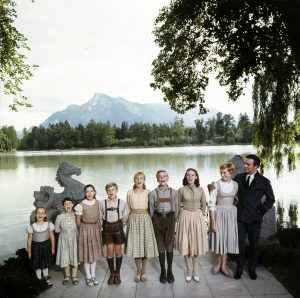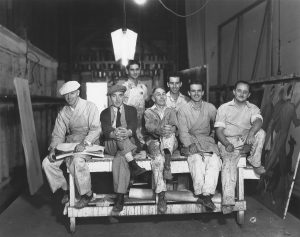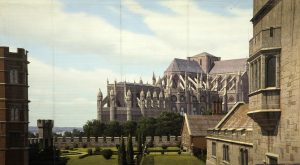
Remember Alfred Hitchcock’s 1959 film North By Northwest, starring Cary Grant and Eva Marie Saint, and their harrowing descent down the face of Mount Rushmore?
That 2-minute montage defines Hitchcock’s classic film, yet credit went to everyone making the film except the scenic artists who made the dangerous escape possible by creating the 90-foot-wide backdrop depicting Mount Rushmore (yes, it wasn’t real).
That backdrop and more will be coming to the Boca Raton Museum of Art on Wednesday for the first dedicated museum exhibition of its kind: Art of the Hollywood Backdrop: Cinema’s Creative Legacy, running from April 20 to Jan. 22 of next year.
The exhibit, and the backdrop recovery project, created by curators Thomas A. Walsh (past president of the Art Directors Guild) and Karen L. Maness, associate director of Texas Performing Arts Fabrication Studios, seek to bring long-overdue credit to the artisans who made a certain kind of movie magic happen.
“It is miraculous that these historic monumental paintings were not lost forever, as so many Hollywood treasures have disappeared,” said Irvin Lippman, executive director of the Boca museum.
Among the other 22 memorable backdrops on display, made between 1938 and 1968, are Ben-Hur’s Rome, the von Trapp family’s Austrian Alps and Gene Kelly’s Paris street dance scene.
The exhibit was conceived in February 2020 after Lippman watched a CBS Sunday Morning segment on this lost art form and of the effort to preserve the backdrops that were stored in the basement of MGM’s studios.

It highlighted Maness’s and Walsh’s efforts to salvage thousands of backdrops from the dustbins of history and to give them their proper attribution.
“I’m so excited that these artists who were never given credit for their work are being seen,” Maness says. “They were extraordinary painters; the mark-making is so immediate, fresh and confident.”
She notes that the backdrops were designed to “snap into realism” at a distance through the camera, but up close one is able to see the artists’ ink making and markings.
“I continue to be inspired by them as artists,” says Maness, herself a professional studio artist. “And
I’m excited to train the next generation of digital and analog artists who can learn from these masters.”
In 2016, Maness and stage designer Richard M. Isackes collaborated on a book, The Art of the Hollywood Backdrop, to highlight the efforts to preserve the backings and make them available for study. (The book is currently out of print, but there will be 24 available for sale at the museum during the exhibit.)

Maness set out to interview some of the remaining scenic artists. “I became an accidental historian,” she says. “This is a story that wants to be told.
“This is the first time this story has been chronicled,” says Maness, who has spent 10 years on this project. “I’m honored to make these artists seen and known.”
One of the best-known scenic artists of that era was George Gibson, who worked for MGM for 34 years and left his mark on such iconic films as The Wizard of Oz (1939), An American in Paris (1951), Brigadoon (1954) and North by Northwest (1959).
“Despite being among the largest paintings ever created, they were never recognized in cinematic history nor were the artists,” she says. “And the techniques used in these paintings are the foundation for the evolution of our modern special effects.”
Maness admits she has a special place in her heart for the painting that was the von Trapp terrace in The Sound of Music, a film that was a treasured part of her childhood.

Maness says she was able to definitely attribute the work to John Coakley, a protégé of Gibson.
“It knocked my socks off when I first saw it,” she says.“You can see the freshness of his hand. He clutched the brush with his fingers splayed between it to create the leaf patterns. It has the feel of a plein air painting.”
Unlike Maness, Walsh cannot pick a favorite backdrop.
“It’s like choosing a favorite child,” he says.
“It is difficult for people to get their minds around the awesome size of these magical spaces, until they see them in person,” Walsh says. “People are often shocked and surprised by the scale and visual impact of these massive creations. These are literally some of the largest paintings ever created in the world, similar to cyclorama paintings.”
For the exhibit, interactive video reels were created in Hollywood, telling the stories behind each backdrop. Soundscapes will surround visitors, including atmospheric sound effects related to the original movies and to the scenic vistas.
The show also features an education gallery created especially for this exhibition, showcasing historic tools of the trade used by the artists.
“Their (the scenic artists) unique industrial techniques permitted them to be Norman Rockwell at one moment, and then Turner, Rembrandt or Vermeer at another,” says Walsh.
“It’s important for our collective memory to preserve these paintings,” says Walsh. “The only way to understand how they were painted is to have them as physical evidence and in use as study models.”
“There’s nothing better than the real thing,” he says.
The Art of the Hollywood Backdrop: Cinema’s Creative Legacy runs from April 20 to Jan. 22, 2023. Hours: Wednesday, Friday, Saturday and Sunday, 11 am to 6 pm; Thursday 11 am to 8 pm. Closed Mondays and Tuesdays. Admission: Adults $12; seniors $10; students and children enter free. Visit bocamuseum.org or call (561) 392-2500. The museum will present a series of events and educational presentations for the community throughout the run of the exhibition. Learn more about this special programming at bocamuseum.org.